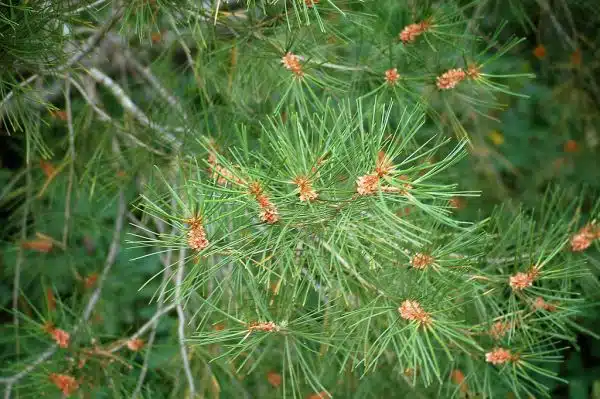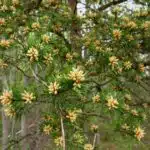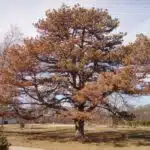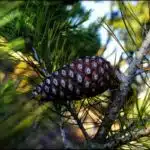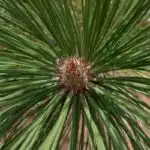Lacebark pine, also known as Pinus bungeana, is a species of tree native to China. It is a popular ornamental tree due to its unique exfoliating bark, which peels away in patches to reveal shades of green, gray, and white. Lacebark pine trees are slow-growing but can reach heights of up to 50 feet.
Growing and caring for lacebark pine trees requires some knowledge and attention to detail. These trees prefer well-drained soil and full sun exposure. They are also drought-tolerant once established but require regular watering during their first few years after planting. Pruning is best done in late winter or early spring before new growth begins. Additionally, proper fertilization and pest management should be implemented to ensure the health and longevity of the tree. By following these guidelines for growing and caring for lacebark pine trees, homeowners can enjoy the beauty of this unique species in their own landscapes while contributing to the health and well-being of their communities through the benefits provided by trees such as air purification, shade provision, and aesthetic enhancement.
Introduction To Lacebark Pine Trees
As a certified arborist, I have always found the Lacebark Pine to be an interesting and unique tree species. In many ways, it can be likened to a person with its distinct personality and characteristics. The Lacebark Pine is native to China and has been cultivated for centuries due to its beauty and hardiness.
The history of the Lacebark Pine dates back to ancient Chinese gardens where it was often used as a focal point or accent tree. It was also prized for its bark which peels away in thin layers, revealing different colors and textures underneath. Today, this tree is commonly planted in parks, gardens, and residential landscapes throughout the world.
One of the most notable features of the Lacebark Pine is its slow growth rate. While some may see this as a disadvantage, it actually makes this tree an excellent choice for those looking for a low-maintenance option. With proper care and attention, the Lacebark Pine can thrive for years to come. In the next section, we will delve deeper into understanding the unique characteristics of this fascinating tree species.
Understanding The Unique Characteristics Of Lacebark Pine Trees
Lacebark pine trees, also known as Pinus bungeana, are unique in their appearance and growth patterns. These trees have several distinguishing features that make them stand out from other pine species. One of the most notable characteristics of the lacebark pine is its multi-colored bark. The bark of this tree peels away in patches, revealing a range of colors, including white, green, brown, and purple. This feature gives the lacebark pine an attractive ornamental quality and makes it a popular choice for landscaping.
Another unique feature of the lacebark pine tree is its growth pattern. Unlike many other types of pines that grow straight up with regular branches, this tree has a more irregular shape with twisting branches that create an interesting silhouette against the sky. This growth pattern makes it an excellent choice for adding visual interest to landscapes or gardens.
If you’re considering planting a lacebark pine tree in your yard, it’s essential to understand these unique features and growth patterns. Here are four key items to keep in mind:
- Lacebark pine trees prefer full sun or partial shade.
- They require well-drained soil with good airflow.
- These trees can adapt to various soil types but prefer slightly acidic soil.
- Regular pruning can help maintain the desirable shape and size of your lacebark pine tree.
Understanding these factors will help you choose the right location for your tree and ensure that it thrives in your landscape or garden. In the next section, we’ll discuss how to select the perfect spot for your new lacebark pine tree without compromising its health or longevity.
Choosing The Right Location For Your Lacebark Pine Tree
Understanding the unique characteristics of lacebark pine trees is crucial in ensuring that they thrive in your garden. As an arborist, I recommend that you choose the right location for your tree to ensure it grows healthy and strong. Before planting, it is essential to understand the soil requirements and sun exposure needed for this species.
Lacebark pine trees prefer well-draining soils with a pH range of 5.0-7.0. Soil with a high clay content can lead to waterlogging, which is detrimental to the growth of these trees. Adding organic matter such as compost or aged manure can help improve soil structure and add nutrients necessary for optimal growth. When planting, avoid compacting the soil around the root system as this can damage the roots and stunt growth.
Sun exposure is another crucial factor when growing lacebark pine trees. These trees require full sun exposure to thrive, but they can tolerate partial shade in warmer regions. Choosing a location that receives at least six hours of direct sunlight daily ensures that your tree grows healthy and strong. Avoid planting near structures or other taller plants that may cast a shadow on your lacebark pine tree.
Incorporating these soil requirements and sun exposure guidelines when choosing a location for your lacebark pine tree will ensure its successful growth and development. In the next section, we will discuss how to plant your lacebark pine tree properly to enhance its chances of thriving in its new environment.
Planting Your Lacebark Pine Tree
Did you know that lacebark pine trees are native to China and can grow up to 50 feet tall? These trees are known for their unique bark that peels away in layers, revealing a colorful patchwork of creamy white, cinnamon, and olive green. If you’re planning on planting a lacebark pine tree in your yard, it’s important to prepare the soil properly before planting.
Start by selecting a location that receives full sun or partial shade. Lacebark pines prefer well-draining soils with a pH between 5.0 and 7.5. Before planting, amend the soil with organic matter such as compost or aged manure to improve drainage and fertility. It’s also important to remove any weeds or debris from the planting area to prevent competition for nutrients.
Once you have prepared the soil, it’s time to plant your lacebark pine tree. Dig a hole that is twice as wide and just as deep as the root ball of your tree. Gently loosen any tangled roots before placing the tree in the hole. Backfill with soil and tamp down lightly around the base of the tree to eliminate air pockets. Finish by mulching around the base of your tree with two to three inches of organic material, such as wood chips or shredded leaves, which will help retain moisture and suppress weed growth.
Now that you’ve successfully planted your lacebark pine tree, it’s important to maintain proper care through watering and fertilizing techniques. In the next section, we’ll discuss how much water your tree needs and when it’s appropriate to apply fertilizer for optimal growth and health.
Watering And Fertilizing Your Lacebark Pine Tree
After successfully planting your lacebark pine tree, it’s time to focus on its growth and care. One of the most critical aspects of caring for a newly planted tree is proper watering. The first year after planting is crucial for establishing the root system, and consistent watering during this period is essential.
Watering Tips:
- Water regularly: During the first year, water your lacebark pine tree once a week.
- Deep watering: To encourage deep root growth, water slowly and deeply to saturate the soil around the roots.
- Mulching: Adding a layer of mulch around the base of your tree can help retain moisture in the soil and keep weeds at bay.
Fertilizing techniques are also important to ensure healthy growth and development of your lacebark pine tree. Pine trees are typically light feeders, so it’s crucial not to over-fertilize them. Over-fertilization can lead to excessive foliage growth, which can weaken the branches and make them more susceptible to damage from wind or snow.
Fertilizing Techniques:
- Timing: Wait until after the first growing season before applying fertilizer.
- Slow-release fertilizers: Use slow-release fertilizers that will provide nutrients over an extended period.
- Avoid nitrogen-rich fertilizers: Nitrogen-rich fertilizers can promote excessive foliage growth, leaving your tree vulnerable to damage.
Proper watering and fertilizing techniques are critical for maintaining healthy lacebark pine trees. By following these tips, you can help ensure that your newly planted tree has everything it needs to thrive in its new environment. In the next section, we’ll discuss pruning and maintenance tips for keeping your lacebark pine tree healthy well into maturity.
Pruning And Maintenance Tips For Lacebark Pine Trees
Pruning lacebark pine trees is necessary to maintain their shape and improve their overall health. It is recommended that pruning occur during the early spring or late winter, before the tree’s new growth has begun. Fertilizing lacebark pine trees helps to provide the necessary nutrients for healthy growth and can be done once or twice a year. Watering lacebark pines should be done regularly and deeply to ensure they are receiving adequate moisture. When watering, an arborist should consider the local climate, soil type, and tree size when determining the frequency and amount of water necessary to keep the tree healthy.
Pruning
Pruning is an essential part of maintenance for lacebark pine trees. One of the key pruning techniques for this tree is removing dead, diseased, or damaged branches. This not only improves the overall appearance of the tree but also reduces the risk of further damage or disease. It is important to use proper pruning techniques to avoid injuring the tree and promote healthy growth.
Timing of pruning is crucial when it comes to lacebark pine trees. It is recommended to prune during late winter or early spring, before new growth begins. Avoid pruning during summer as this can cause stress on the tree and make it susceptible to disease and insect infestations. Pruning during fall should also be avoided as this can interfere with the natural shedding of leaves and preparation for winter dormancy.
Pruning can greatly benefit the growth and health of your lacebark pine tree if done correctly. By removing dead branches, you are allowing for more sunlight and air circulation, promoting healthy growth throughout the entire tree. Additionally, shaping and thinning out dense areas can improve aesthetics while reducing weight on certain branches that may be prone to breaking under heavy snow or wind loads. Remember to always use proper pruning techniques and timing to ensure the best results for your lacebark pine tree’s health and longevity.
Fertilizing
In addition to pruning, fertilizing is also an essential part of maintaining a healthy lacebark pine tree. Fertilizers provide necessary nutrients to the soil and promote healthy growth. There are two types of fertilizers available: organic and chemical. Organic fertilizers are made from natural materials such as compost or manure, while chemical fertilizers are synthetic compounds manufactured for plant nutrition.
The frequency and timing of fertilizing depend on various factors such as soil type, climate, and age of the tree. In general, it is recommended to fertilize once a year during early spring when new growth begins. However, if the tree is showing signs of nutrient deficiency such as yellowing leaves or stunted growth, additional fertilizer applications may be necessary.
When selecting a fertilizer for your lacebark pine tree, it is important to choose one that meets its specific needs. A soil test can help determine which nutrients are lacking in the soil and guide fertilizer selection. Additionally, following proper application rates and techniques can prevent overfertilization which can harm the tree’s roots and surrounding environment. By incorporating proper fertilization practices into your maintenance routine, you can ensure the health and longevity of your lacebark pine tree.
Watering
As certified arborists, it is important to understand that pruning and fertilizing alone are not enough to maintain a healthy lacebark pine tree. Adequate watering is also essential in promoting tree health and longevity. Watering frequency and soil moisture levels must be carefully monitored to ensure that the tree receives sufficient water without causing damage.
The frequency of watering depends on various factors such as climate, soil type, and age of the tree. In general, it is recommended to water once or twice a week during the growing season when rainfall is insufficient. However, overwatering can lead to root rot and other diseases, so it is crucial to monitor soil moisture levels using a soil moisture meter or by checking the soil’s texture.
To determine if your lacebark pine tree needs watering, check the soil moisture level by inserting a screwdriver or similar tool into the ground. If the tool easily penetrates the soil, then it indicates that there is sufficient moisture. If not, it may be time to water. By incorporating proper watering practices into your maintenance routine such as monitoring soil moisture levels and avoiding overwatering, you can ensure the health and longevity of your lacebark pine tree.
Common Pests And Diseases To Watch Out For
Did you know that lacebark pine is generally a hardy tree? However, it is still susceptible to pests and diseases that can cause serious damage. Thus, it is crucial to keep an eye out for these potential problems and take preventative measures accordingly.
The most common pests that attack lacebark pine are spider mites, scale insects, and sawflies. Spider mites are tiny arachnids that suck the sap from the needles. Scale insects also feed on plant sap and can be identified by their waxy coating. Sawflies are caterpillar-like insects that consume the needles of young trees. To prevent these pests from wreaking havoc on your lacebark pine, regularly inspect your tree for signs of infestation such as yellowing needles or sticky residue on the bark. Additionally, pruning off affected branches or using insecticidal soap can help control these pests.
Lacebark pine is also prone to several diseases such as root rot, tip blight, and rust diseases. Root rot occurs when the roots become waterlogged due to poor drainage, leading to fungal growth and decay. Tip blight causes needle discoloration and premature needle drop on young shoots. Rust diseases create yellow-orange spots on needles in spring and summer months. Preventative measures include ensuring proper soil drainage, avoiding overhead watering, and maintaining good air circulation around the tree. Treatment options may include fungicides or removing infected branches or trees altogether.
Identifying and treating lacebark pine tree problems is essential for keeping this beautiful tree healthy and strong. In the next section, we will discuss how to recognize these issues so you can take action promptly if necessary.
Identifying And Treating Lacebark Pine Tree Problems
As a certified arborist, it is essential to identify and treat the problems that lacebark pine trees encounter. Identifying pests such as the Zimmerman pine moth, mountain pine beetle, and pine needle scale early on can prevent serious damage to the tree. The Zimmerman pine moth larvae tunnel under the bark of the tree, causing dieback of branches. Mountain pine beetles lay eggs under the bark of weakened trees, leading to extensive damage and death. Pine needle scales cause yellowing and premature loss of needles. Thoroughly inspecting your lacebark pine for these pests will help you take necessary action.
Treating diseases is also crucial for maintaining healthy lacebark pines. Needlecast diseases such as Dothistroma and Lophodermium cause premature needle drop, which can lead to defoliation if not treated promptly. Canker diseases caused by fungi such as Diplodia can cause branch dieback and affect the overall health of the tree. Proper cultural practices such as pruning dead branches, providing adequate water and nutrients, and avoiding mechanical damage can help prevent disease spread.
Regular monitoring of your lacebark pine’s health is key in preventing pest infestations and disease outbreaks. If you notice any signs of pests or diseases during inspection, it is important to take action immediately to prevent further damage or spread. Consulting a professional arborist or horticulturist may be necessary for proper diagnosis and treatment options.
To further enhance your knowledge about growing lacebark pines in your landscape, let’s explore some benefits that this tree species offers.
Benefits Of Growing Lacebark Pine Trees In Your Landscape
The beauty of lacebark pine trees can be a great addition to any landscape design. These trees have a unique appearance, with their textured bark and needles that come in different shades of green and blue. They are also low-maintenance, making them an ideal choice for homeowners who want to add some visual interest to their property without having to spend too much time on upkeep.
One of the benefits of growing lacebark pine trees is their ability to provide shade during hot summer months. This can help reduce cooling costs, as the tree’s canopy will block direct sunlight from reaching your home or patio area. Additionally, these trees are known for their resistance to pests and diseases, which means you won’t have to worry about spending money on expensive treatments.
Landscaping ideas for lacebark pine trees include using them as focal points in your yard or garden. You can plant them in groups or around other plants to create a layered look. They also work well as hedges or screens, providing privacy while adding visual interest to your property. When designing your landscape, consider incorporating other plants that complement the colors and textures of the lacebark pine tree.
Enjoying the beauty and benefits of lacebark pine trees in your community is easy when you know how to care for them properly. With their low-maintenance requirements and natural pest resistance, these trees are an excellent choice for homeowners who want to add some visual interest to their yards without having to spend too much time on upkeep. Whether you choose to use them as focal points or as part of a larger landscaping scheme, lacebark pines are sure to make a statement in any setting.
Conclusion: Enjoying The Beauty And Benefits Of Lacebark Pine Trees In Your Community
Lacebark pine trees are a beautiful addition to any community. Not only do they provide aesthetic value with their unique bark patterns, but they also offer several benefits to the environment. These trees are drought-tolerant, disease-resistant and can survive in harsh weather conditions. By planting them in public spaces, we can increase public awareness of the importance of trees in our urban areas.
Community involvement is essential when it comes to caring for lacebark pines. It takes a group effort to ensure that these trees receive the proper care and maintenance they need to thrive. This involves regular pruning, mulching, and watering during dry periods. With proper care, lacebark pine trees can live up to 500 years or more.
By planting lacebark pine trees in our communities, we not only enhance the beauty of our surroundings but also contribute to the health of our environment. As certified arborists or horticulturists, we encourage everyone to get involved in this effort by volunteering their time or resources towards planting and maintaining these beautiful trees. Together we can make a difference and create a better world for ourselves and future generations.
- Lacebark pine trees are drought-tolerant and disease-resistant.
- Proper care involves regular pruning, mulching, and watering during dry periods.
- Planting lacebark pines can enhance the beauty of our surroundings and contribute to the health of our environment.
- Community involvement is essential in caring for these trees.
- Public awareness about the importance of planting trees in urban areas is crucial for sustainability efforts.
Conclusion
Lacebark pine trees are a unique and beautiful addition to any landscape. As a certified arborist, I urge you to understand the characteristics of this tree before planting it in your yard. Choose a location that provides adequate sunlight and well-draining soil. Proper watering and fertilization will ensure healthy growth and prevent common pests and diseases.
If your lacebark pine experiences any problems, it is important to identify them early on and take appropriate action. This may include treating for pests or pruning damaged branches. By taking care of your lacebark pine tree, you can enjoy its benefits for years to come, such as its stunning bark texture and year-round interest.
In conclusion, growing and caring for lacebark pine trees requires attention to detail but is ultimately rewarding. As an arborist or horticulturist, we strive to promote the health and longevity of all plants in our communities. Adding a unique species like the lacebark pine only enhances the beauty of our surroundings and creates a more diverse ecosystem for future generations to enjoy.
Image Credits
- “Lacebark pine needles” by Tony Frates (featured)

